Personal & Professional Development Plan: A Comprehensive Report
VerifiedAdded on 2020/01/28
|18
|4786
|46
Report
AI Summary
This report provides a detailed analysis of personal and professional development, emphasizing the importance of self-managed learning. It identifies various approaches to self-managed learning, evaluates their suitability for different learning styles, and recommends learning and development methods. The report also evaluates the benefits of self-managed learning and addresses work-based problems by implementing appropriate learning styles and time-management strategies. Furthermore, it assesses current skills and competencies against organizational objectives, identifies development needs, and devises a personal development plan with short-term and long-term objectives. The report concludes with a critical discussion of own learning against the aims and objectives of a PDP and provides an updated PDP.
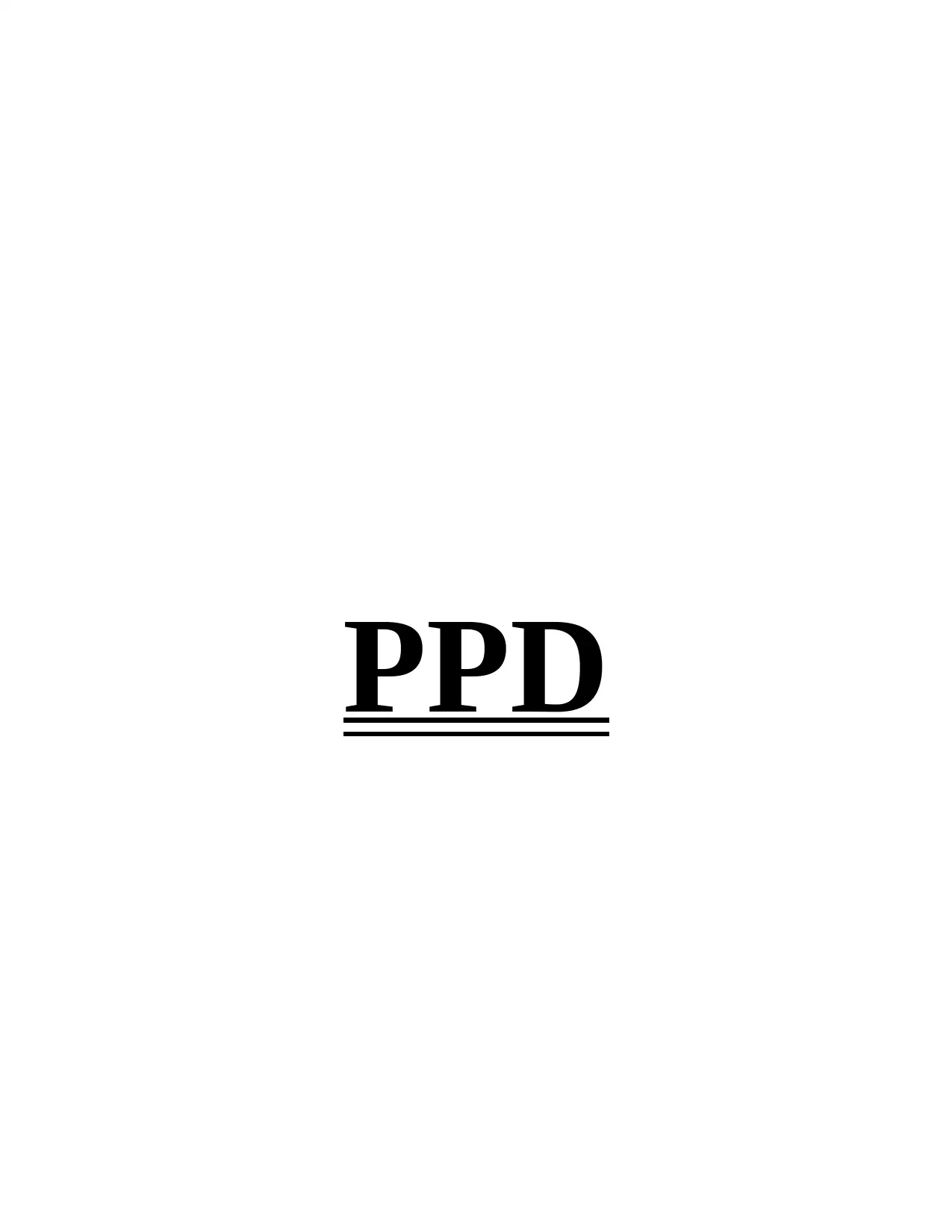
PPD
Paraphrase This Document
Need a fresh take? Get an instant paraphrase of this document with our AI Paraphraser
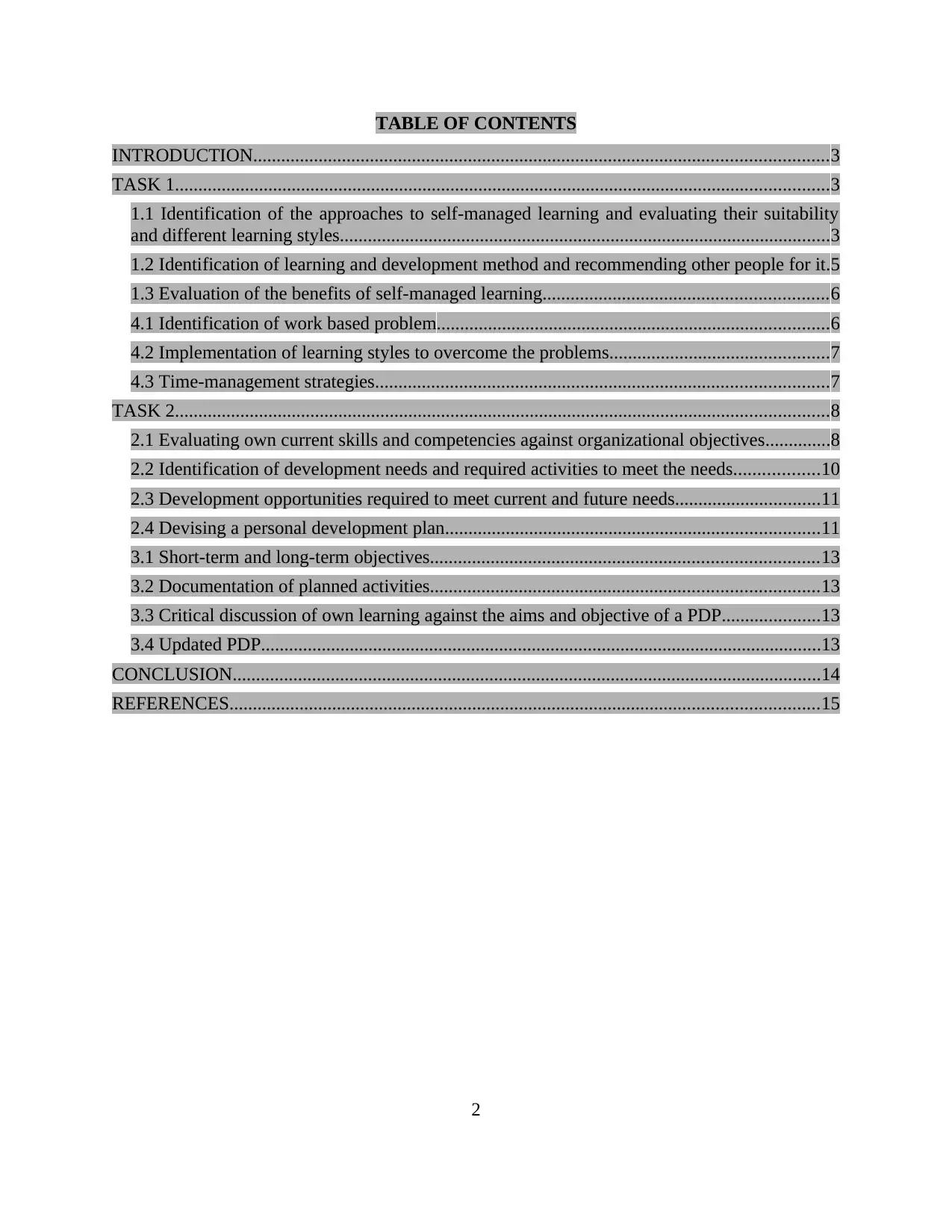
TABLE OF CONTENTS
INTRODUCTION...........................................................................................................................3
TASK 1............................................................................................................................................3
1.1 Identification of the approaches to self-managed learning and evaluating their suitability
and different learning styles.........................................................................................................3
1.2 Identification of learning and development method and recommending other people for it.5
1.3 Evaluation of the benefits of self-managed learning.............................................................6
4.1 Identification of work based problem....................................................................................6
4.2 Implementation of learning styles to overcome the problems...............................................7
4.3 Time-management strategies.................................................................................................7
TASK 2............................................................................................................................................8
2.1 Evaluating own current skills and competencies against organizational objectives..............8
2.2 Identification of development needs and required activities to meet the needs..................10
2.3 Development opportunities required to meet current and future needs...............................11
2.4 Devising a personal development plan................................................................................11
3.1 Short-term and long-term objectives...................................................................................13
3.2 Documentation of planned activities...................................................................................13
3.3 Critical discussion of own learning against the aims and objective of a PDP.....................13
3.4 Updated PDP........................................................................................................................13
CONCLUSION..............................................................................................................................14
REFERENCES..............................................................................................................................15
2
INTRODUCTION...........................................................................................................................3
TASK 1............................................................................................................................................3
1.1 Identification of the approaches to self-managed learning and evaluating their suitability
and different learning styles.........................................................................................................3
1.2 Identification of learning and development method and recommending other people for it.5
1.3 Evaluation of the benefits of self-managed learning.............................................................6
4.1 Identification of work based problem....................................................................................6
4.2 Implementation of learning styles to overcome the problems...............................................7
4.3 Time-management strategies.................................................................................................7
TASK 2............................................................................................................................................8
2.1 Evaluating own current skills and competencies against organizational objectives..............8
2.2 Identification of development needs and required activities to meet the needs..................10
2.3 Development opportunities required to meet current and future needs...............................11
2.4 Devising a personal development plan................................................................................11
3.1 Short-term and long-term objectives...................................................................................13
3.2 Documentation of planned activities...................................................................................13
3.3 Critical discussion of own learning against the aims and objective of a PDP.....................13
3.4 Updated PDP........................................................................................................................13
CONCLUSION..............................................................................................................................14
REFERENCES..............................................................................................................................15
2
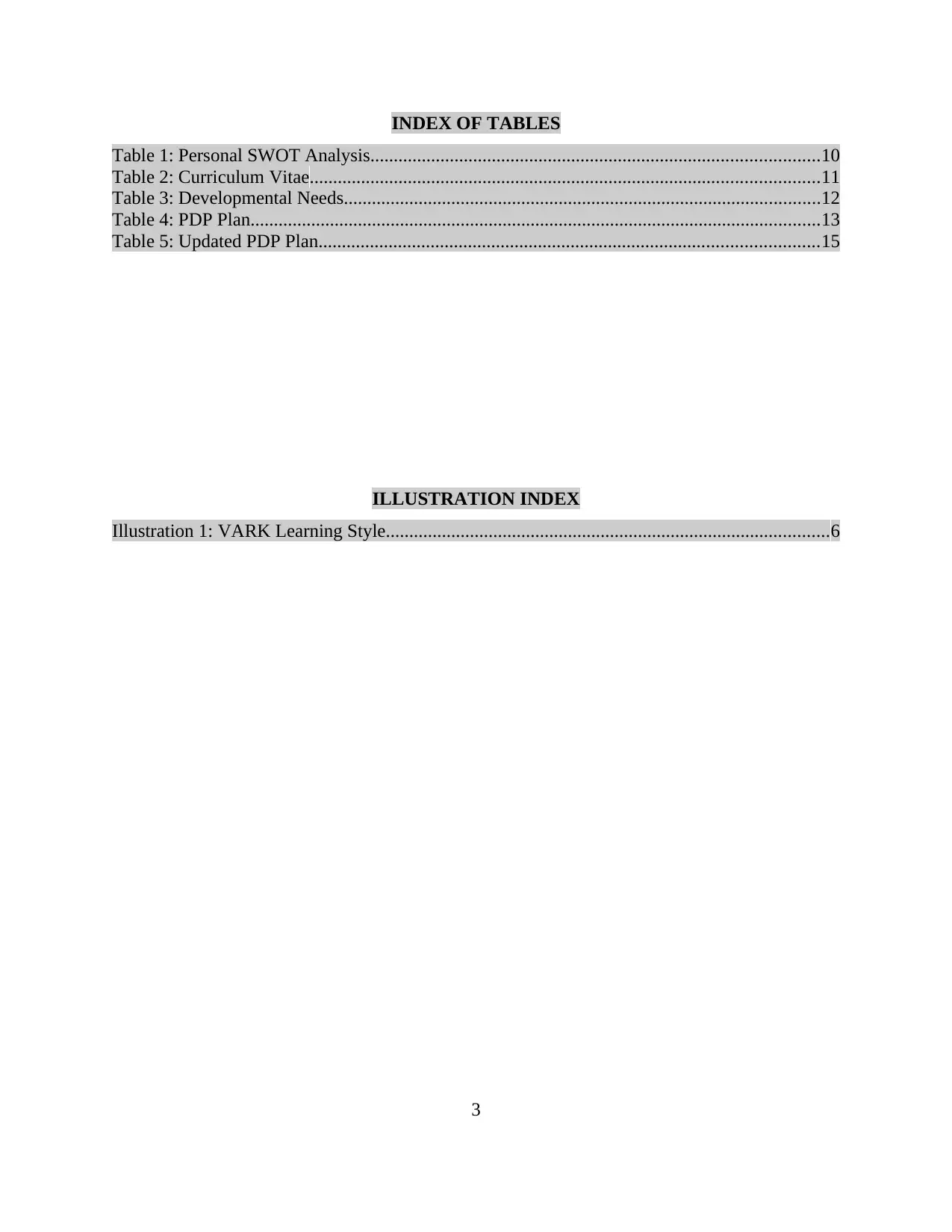
INDEX OF TABLES
Table 1: Personal SWOT Analysis................................................................................................10
Table 2: Curriculum Vitae.............................................................................................................11
Table 3: Developmental Needs......................................................................................................12
Table 4: PDP Plan..........................................................................................................................13
Table 5: Updated PDP Plan...........................................................................................................15
ILLUSTRATION INDEX
Illustration 1: VARK Learning Style...............................................................................................6
3
Table 1: Personal SWOT Analysis................................................................................................10
Table 2: Curriculum Vitae.............................................................................................................11
Table 3: Developmental Needs......................................................................................................12
Table 4: PDP Plan..........................................................................................................................13
Table 5: Updated PDP Plan...........................................................................................................15
ILLUSTRATION INDEX
Illustration 1: VARK Learning Style...............................................................................................6
3
⊘ This is a preview!⊘
Do you want full access?
Subscribe today to unlock all pages.

Trusted by 1+ million students worldwide
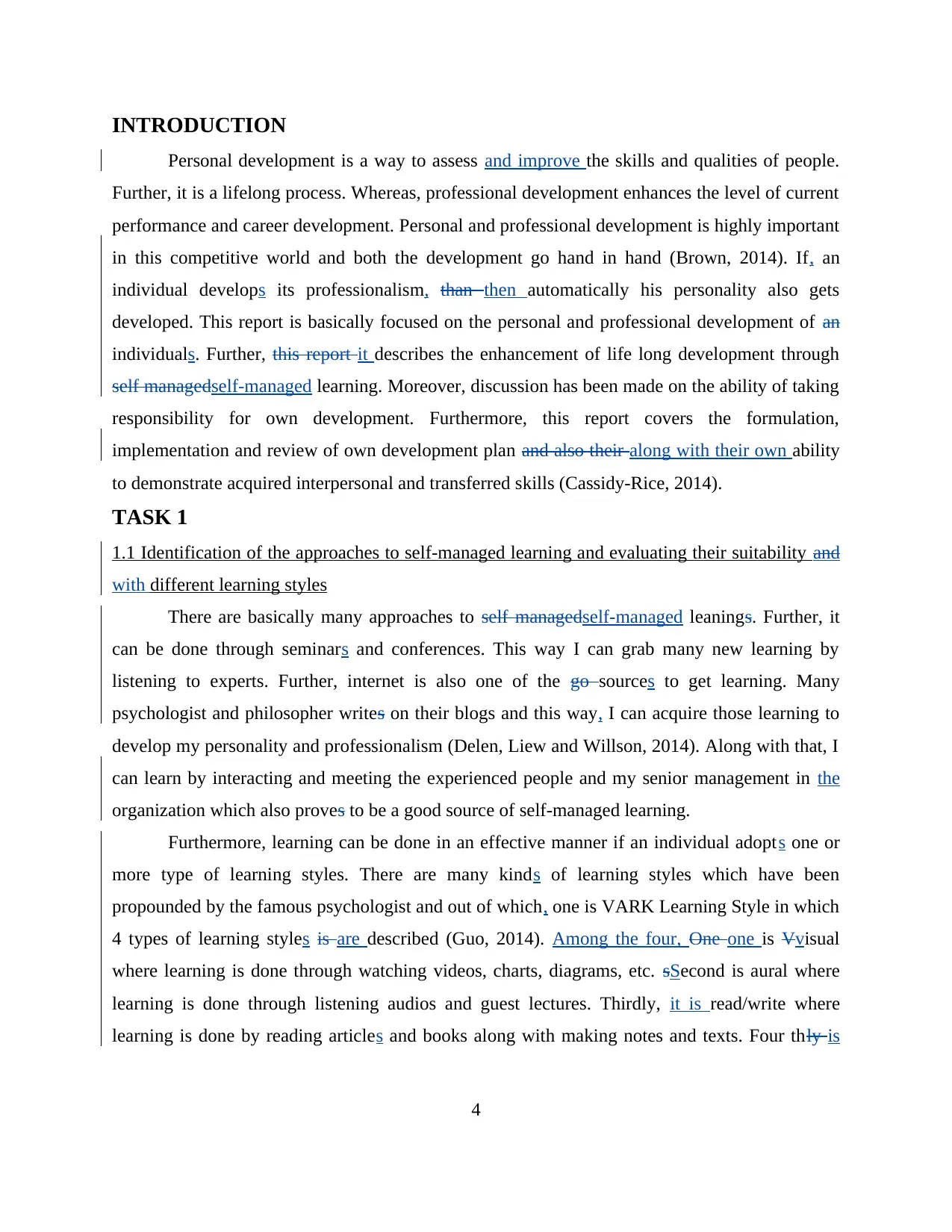
INTRODUCTION
Personal development is a way to assess and improve the skills and qualities of people.
Further, it is a lifelong process. Whereas, professional development enhances the level of current
performance and career development. Personal and professional development is highly important
in this competitive world and both the development go hand in hand (Brown, 2014). If, an
individual develops its professionalism, than then automatically his personality also gets
developed. This report is basically focused on the personal and professional development of an
individuals. Further, this report it describes the enhancement of life long development through
self managedself-managed learning. Moreover, discussion has been made on the ability of taking
responsibility for own development. Furthermore, this report covers the formulation,
implementation and review of own development plan and also their along with their own ability
to demonstrate acquired interpersonal and transferred skills (Cassidy-Rice, 2014).
TASK 1
1.1 Identification of the approaches to self-managed learning and evaluating their suitability and
with different learning styles
There are basically many approaches to self managedself-managed leanings. Further, it
can be done through seminars and conferences. This way I can grab many new learning by
listening to experts. Further, internet is also one of the go sources to get learning. Many
psychologist and philosopher writes on their blogs and this way, I can acquire those learning to
develop my personality and professionalism (Delen, Liew and Willson, 2014). Along with that, I
can learn by interacting and meeting the experienced people and my senior management in the
organization which also proves to be a good source of self-managed learning.
Furthermore, learning can be done in an effective manner if an individual adopts one or
more type of learning styles. There are many kinds of learning styles which have been
propounded by the famous psychologist and out of which, one is VARK Learning Style in which
4 types of learning styles is are described (Guo, 2014). Among the four, One one is Vvisual
where learning is done through watching videos, charts, diagrams, etc. sSecond is aural where
learning is done through listening audios and guest lectures. Thirdly, it is read/write where
learning is done by reading articles and books along with making notes and texts. Four thly is
4
Personal development is a way to assess and improve the skills and qualities of people.
Further, it is a lifelong process. Whereas, professional development enhances the level of current
performance and career development. Personal and professional development is highly important
in this competitive world and both the development go hand in hand (Brown, 2014). If, an
individual develops its professionalism, than then automatically his personality also gets
developed. This report is basically focused on the personal and professional development of an
individuals. Further, this report it describes the enhancement of life long development through
self managedself-managed learning. Moreover, discussion has been made on the ability of taking
responsibility for own development. Furthermore, this report covers the formulation,
implementation and review of own development plan and also their along with their own ability
to demonstrate acquired interpersonal and transferred skills (Cassidy-Rice, 2014).
TASK 1
1.1 Identification of the approaches to self-managed learning and evaluating their suitability and
with different learning styles
There are basically many approaches to self managedself-managed leanings. Further, it
can be done through seminars and conferences. This way I can grab many new learning by
listening to experts. Further, internet is also one of the go sources to get learning. Many
psychologist and philosopher writes on their blogs and this way, I can acquire those learning to
develop my personality and professionalism (Delen, Liew and Willson, 2014). Along with that, I
can learn by interacting and meeting the experienced people and my senior management in the
organization which also proves to be a good source of self-managed learning.
Furthermore, learning can be done in an effective manner if an individual adopts one or
more type of learning styles. There are many kinds of learning styles which have been
propounded by the famous psychologist and out of which, one is VARK Learning Style in which
4 types of learning styles is are described (Guo, 2014). Among the four, One one is Vvisual
where learning is done through watching videos, charts, diagrams, etc. sSecond is aural where
learning is done through listening audios and guest lectures. Thirdly, it is read/write where
learning is done by reading articles and books along with making notes and texts. Four thly is
4
Paraphrase This Document
Need a fresh take? Get an instant paraphrase of this document with our AI Paraphraser
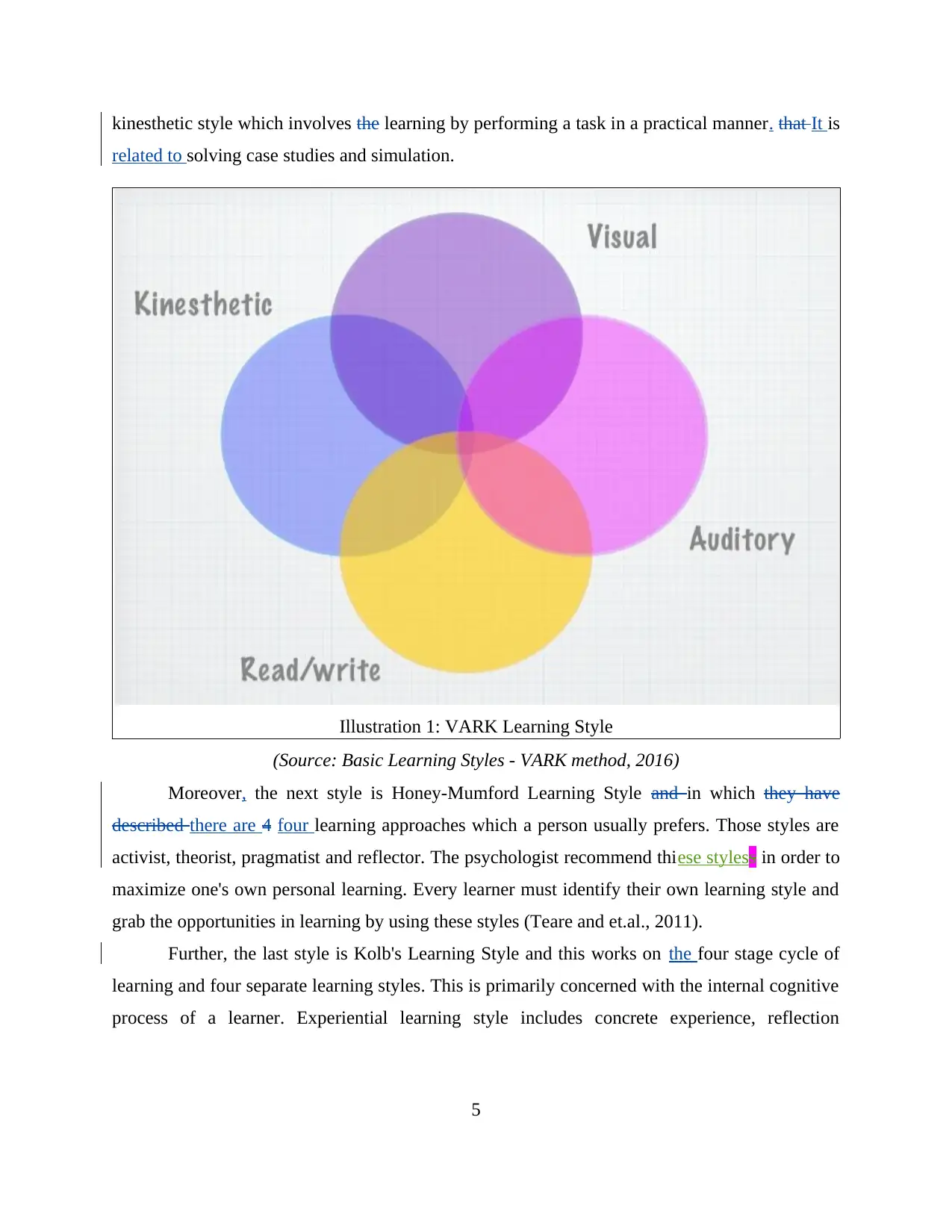
kinesthetic style which involves the learning by performing a task in a practical manner. that It is
related to solving case studies and simulation.
(Source: Basic Learning Styles - VARK method, 2016)
Moreover, the next style is Honey-Mumford Learning Style and in which they have
described there are 4 four learning approaches which a person usually prefers. Those styles are
activist, theorist, pragmatist and reflector. The psychologist recommend thiese styless in order to
maximize one's own personal learning. Every learner must identify their own learning style and
grab the opportunities in learning by using these styles (Teare and et.al., 2011).
Further, the last style is Kolb's Learning Style and this works on the four stage cycle of
learning and four separate learning styles. This is primarily concerned with the internal cognitive
process of a learner. Experiential learning style includes concrete experience, reflection
5
Illustration 1: VARK Learning Style
related to solving case studies and simulation.
(Source: Basic Learning Styles - VARK method, 2016)
Moreover, the next style is Honey-Mumford Learning Style and in which they have
described there are 4 four learning approaches which a person usually prefers. Those styles are
activist, theorist, pragmatist and reflector. The psychologist recommend thiese styless in order to
maximize one's own personal learning. Every learner must identify their own learning style and
grab the opportunities in learning by using these styles (Teare and et.al., 2011).
Further, the last style is Kolb's Learning Style and this works on the four stage cycle of
learning and four separate learning styles. This is primarily concerned with the internal cognitive
process of a learner. Experiential learning style includes concrete experience, reflection
5
Illustration 1: VARK Learning Style
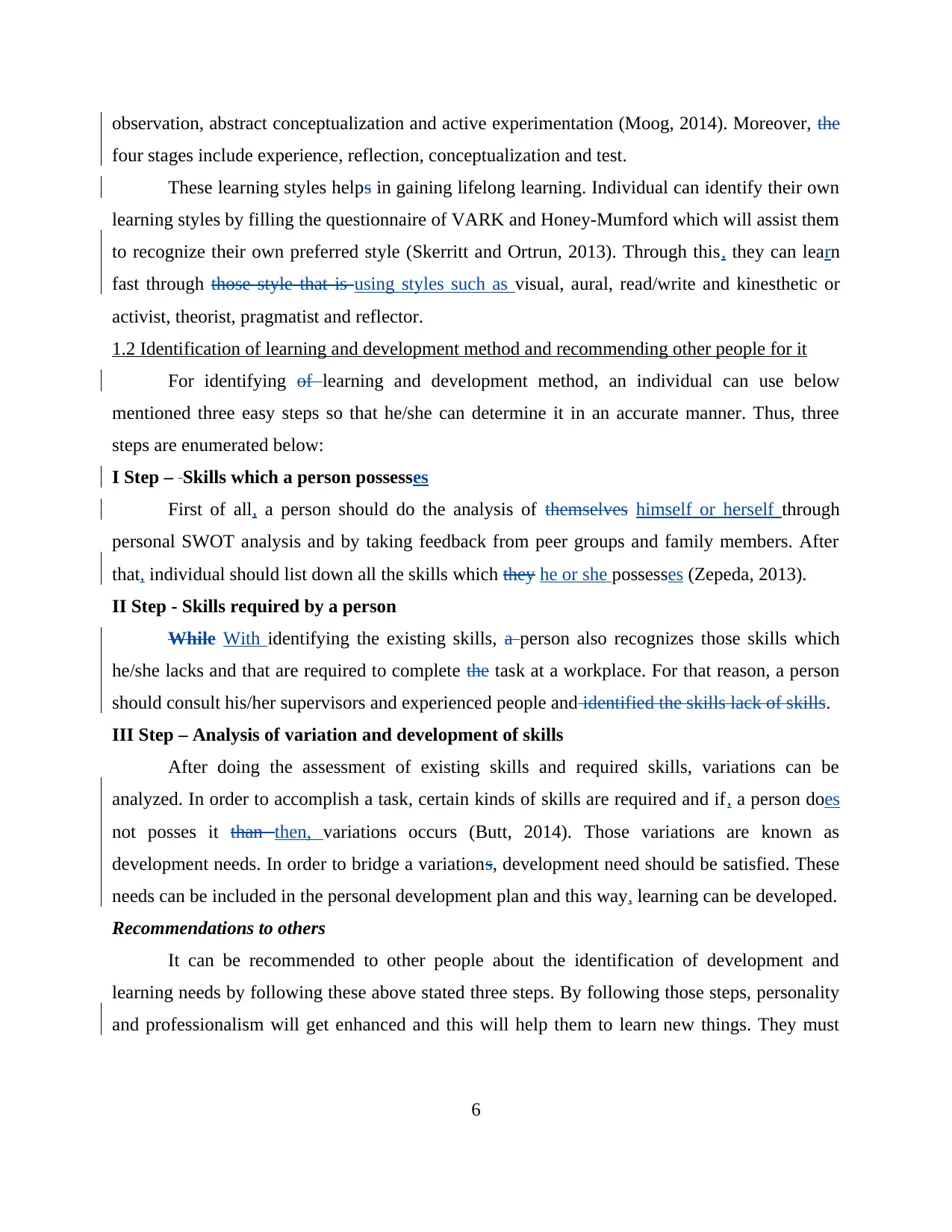
observation, abstract conceptualization and active experimentation (Moog, 2014). Moreover, the
four stages include experience, reflection, conceptualization and test.
These learning styles helps in gaining lifelong learning. Individual can identify their own
learning styles by filling the questionnaire of VARK and Honey-Mumford which will assist them
to recognize their own preferred style (Skerritt and Ortrun, 2013). Through this, they can learn
fast through those style that is using styles such as visual, aural, read/write and kinesthetic or
activist, theorist, pragmatist and reflector.
1.2 Identification of learning and development method and recommending other people for it
For identifying of learning and development method, an individual can use below
mentioned three easy steps so that he/she can determine it in an accurate manner. Thus, three
steps are enumerated below:
I Step – Skills which a person possesses
First of all, a person should do the analysis of themselves himself or herself through
personal SWOT analysis and by taking feedback from peer groups and family members. After
that, individual should list down all the skills which they he or she possesses (Zepeda, 2013).
II Step - Skills required by a person
While With identifying the existing skills, a person also recognizes those skills which
he/she lacks and that are required to complete the task at a workplace. For that reason, a person
should consult his/her supervisors and experienced people and identified the skills lack of skills.
III Step – Analysis of variation and development of skills
After doing the assessment of existing skills and required skills, variations can be
analyzed. In order to accomplish a task, certain kinds of skills are required and if, a person does
not posses it than then, variations occurs (Butt, 2014). Those variations are known as
development needs. In order to bridge a variations, development need should be satisfied. These
needs can be included in the personal development plan and this way, learning can be developed.
Recommendations to others
It can be recommended to other people about the identification of development and
learning needs by following these above stated three steps. By following those steps, personality
and professionalism will get enhanced and this will help them to learn new things. They must
6
four stages include experience, reflection, conceptualization and test.
These learning styles helps in gaining lifelong learning. Individual can identify their own
learning styles by filling the questionnaire of VARK and Honey-Mumford which will assist them
to recognize their own preferred style (Skerritt and Ortrun, 2013). Through this, they can learn
fast through those style that is using styles such as visual, aural, read/write and kinesthetic or
activist, theorist, pragmatist and reflector.
1.2 Identification of learning and development method and recommending other people for it
For identifying of learning and development method, an individual can use below
mentioned three easy steps so that he/she can determine it in an accurate manner. Thus, three
steps are enumerated below:
I Step – Skills which a person possesses
First of all, a person should do the analysis of themselves himself or herself through
personal SWOT analysis and by taking feedback from peer groups and family members. After
that, individual should list down all the skills which they he or she possesses (Zepeda, 2013).
II Step - Skills required by a person
While With identifying the existing skills, a person also recognizes those skills which
he/she lacks and that are required to complete the task at a workplace. For that reason, a person
should consult his/her supervisors and experienced people and identified the skills lack of skills.
III Step – Analysis of variation and development of skills
After doing the assessment of existing skills and required skills, variations can be
analyzed. In order to accomplish a task, certain kinds of skills are required and if, a person does
not posses it than then, variations occurs (Butt, 2014). Those variations are known as
development needs. In order to bridge a variations, development need should be satisfied. These
needs can be included in the personal development plan and this way, learning can be developed.
Recommendations to others
It can be recommended to other people about the identification of development and
learning needs by following these above stated three steps. By following those steps, personality
and professionalism will get enhanced and this will help them to learn new things. They must
6
⊘ This is a preview!⊘
Do you want full access?
Subscribe today to unlock all pages.

Trusted by 1+ million students worldwide
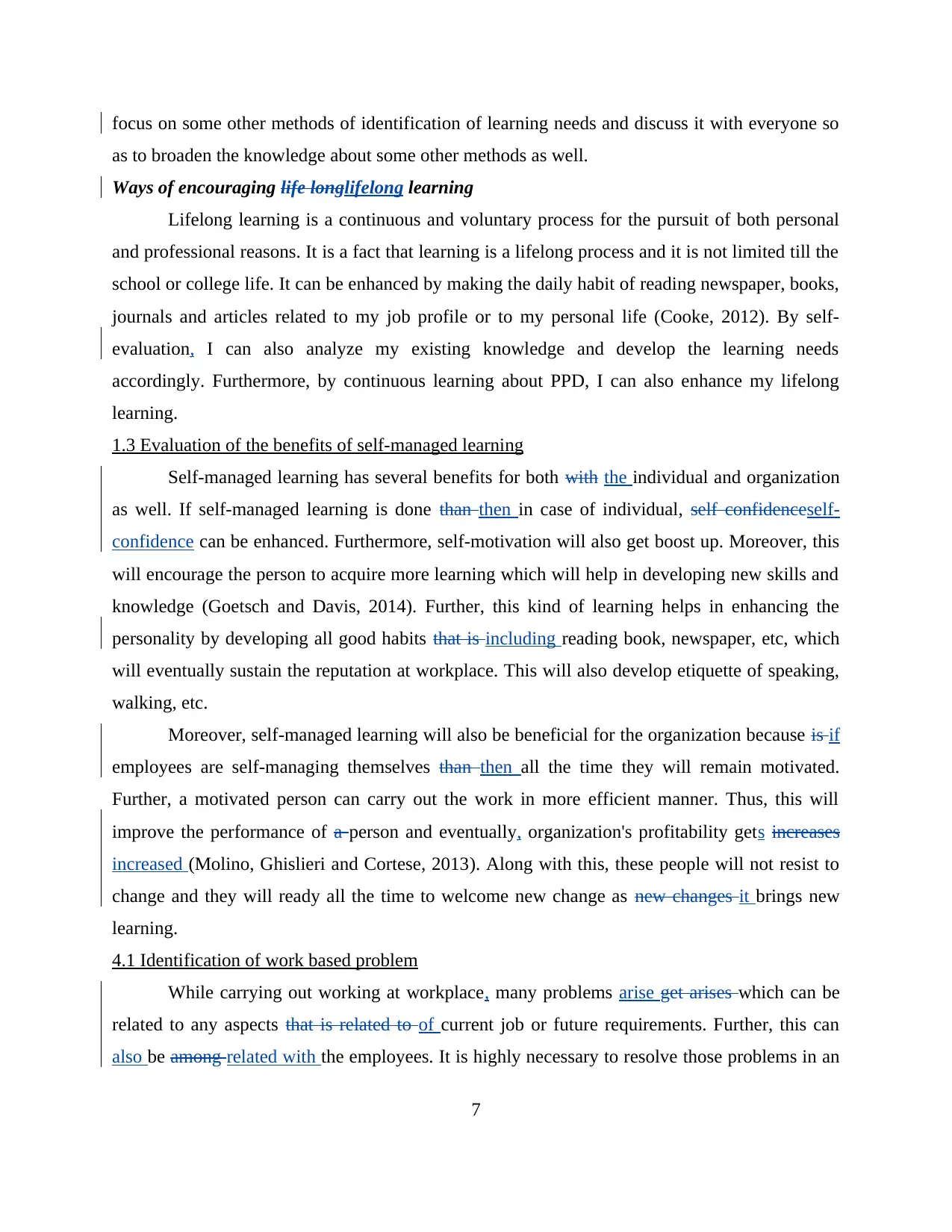
focus on some other methods of identification of learning needs and discuss it with everyone so
as to broaden the knowledge about some other methods as well.
Ways of encouraging life longlifelong learning
Lifelong learning is a continuous and voluntary process for the pursuit of both personal
and professional reasons. It is a fact that learning is a lifelong process and it is not limited till the
school or college life. It can be enhanced by making the daily habit of reading newspaper, books,
journals and articles related to my job profile or to my personal life (Cooke, 2012). By self-
evaluation, I can also analyze my existing knowledge and develop the learning needs
accordingly. Furthermore, by continuous learning about PPD, I can also enhance my lifelong
learning.
1.3 Evaluation of the benefits of self-managed learning
Self-managed learning has several benefits for both with the individual and organization
as well. If self-managed learning is done than then in case of individual, self confidenceself-
confidence can be enhanced. Furthermore, self-motivation will also get boost up. Moreover, this
will encourage the person to acquire more learning which will help in developing new skills and
knowledge (Goetsch and Davis, 2014). Further, this kind of learning helps in enhancing the
personality by developing all good habits that is including reading book, newspaper, etc, which
will eventually sustain the reputation at workplace. This will also develop etiquette of speaking,
walking, etc.
Moreover, self-managed learning will also be beneficial for the organization because is if
employees are self-managing themselves than then all the time they will remain motivated.
Further, a motivated person can carry out the work in more efficient manner. Thus, this will
improve the performance of a person and eventually, organization's profitability gets increases
increased (Molino, Ghislieri and Cortese, 2013). Along with this, these people will not resist to
change and they will ready all the time to welcome new change as new changes it brings new
learning.
4.1 Identification of work based problem
While carrying out working at workplace, many problems arise get arises which can be
related to any aspects that is related to of current job or future requirements. Further, this can
also be among related with the employees. It is highly necessary to resolve those problems in an
7
as to broaden the knowledge about some other methods as well.
Ways of encouraging life longlifelong learning
Lifelong learning is a continuous and voluntary process for the pursuit of both personal
and professional reasons. It is a fact that learning is a lifelong process and it is not limited till the
school or college life. It can be enhanced by making the daily habit of reading newspaper, books,
journals and articles related to my job profile or to my personal life (Cooke, 2012). By self-
evaluation, I can also analyze my existing knowledge and develop the learning needs
accordingly. Furthermore, by continuous learning about PPD, I can also enhance my lifelong
learning.
1.3 Evaluation of the benefits of self-managed learning
Self-managed learning has several benefits for both with the individual and organization
as well. If self-managed learning is done than then in case of individual, self confidenceself-
confidence can be enhanced. Furthermore, self-motivation will also get boost up. Moreover, this
will encourage the person to acquire more learning which will help in developing new skills and
knowledge (Goetsch and Davis, 2014). Further, this kind of learning helps in enhancing the
personality by developing all good habits that is including reading book, newspaper, etc, which
will eventually sustain the reputation at workplace. This will also develop etiquette of speaking,
walking, etc.
Moreover, self-managed learning will also be beneficial for the organization because is if
employees are self-managing themselves than then all the time they will remain motivated.
Further, a motivated person can carry out the work in more efficient manner. Thus, this will
improve the performance of a person and eventually, organization's profitability gets increases
increased (Molino, Ghislieri and Cortese, 2013). Along with this, these people will not resist to
change and they will ready all the time to welcome new change as new changes it brings new
learning.
4.1 Identification of work based problem
While carrying out working at workplace, many problems arise get arises which can be
related to any aspects that is related to of current job or future requirements. Further, this can
also be among related with the employees. It is highly necessary to resolve those problems in an
7
Paraphrase This Document
Need a fresh take? Get an instant paraphrase of this document with our AI Paraphraser
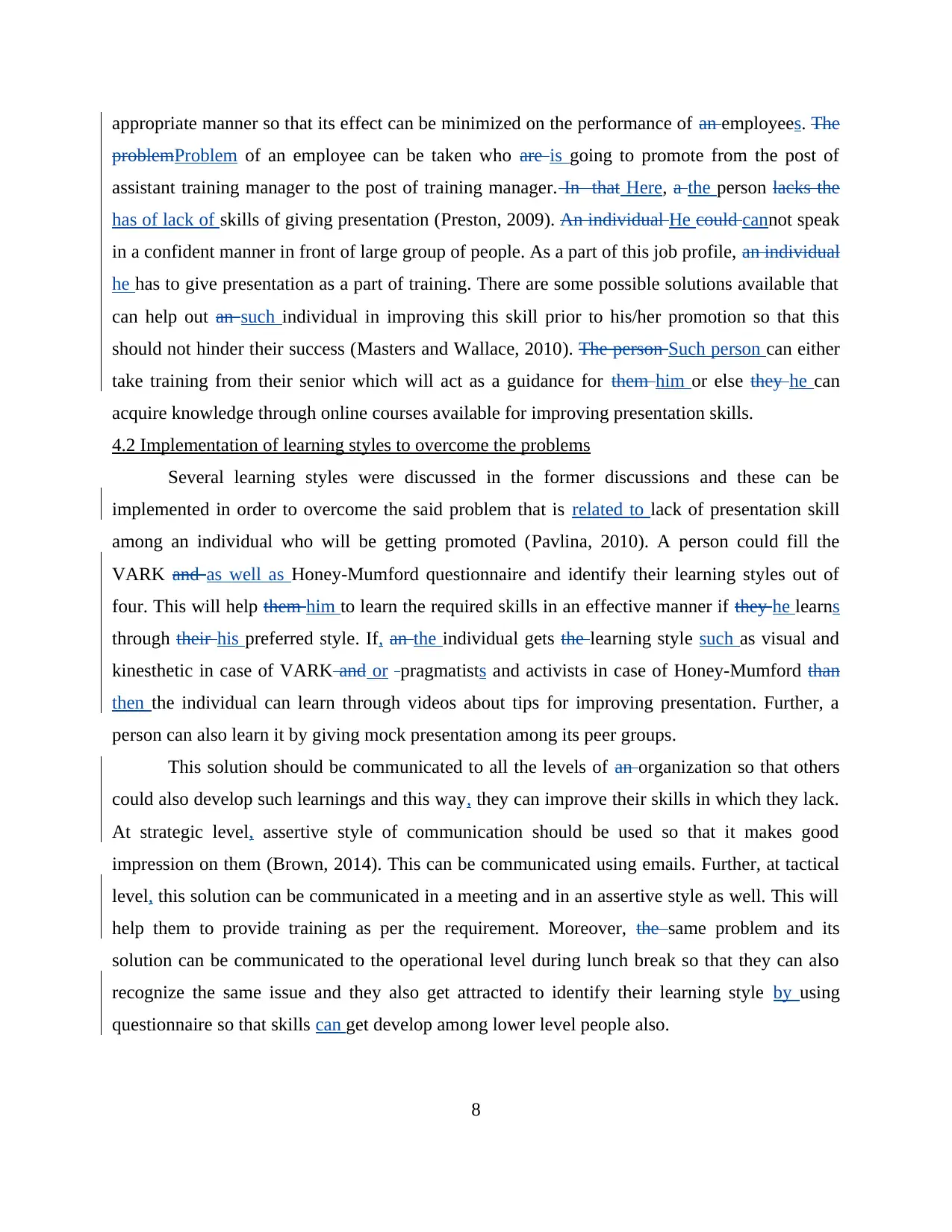
appropriate manner so that its effect can be minimized on the performance of an employees. The
problemProblem of an employee can be taken who are is going to promote from the post of
assistant training manager to the post of training manager. In that Here, a the person lacks the
has of lack of skills of giving presentation (Preston, 2009). An individual He could cannot speak
in a confident manner in front of large group of people. As a part of this job profile, an individual
he has to give presentation as a part of training. There are some possible solutions available that
can help out an such individual in improving this skill prior to his/her promotion so that this
should not hinder their success (Masters and Wallace, 2010). The person Such person can either
take training from their senior which will act as a guidance for them him or else they he can
acquire knowledge through online courses available for improving presentation skills.
4.2 Implementation of learning styles to overcome the problems
Several learning styles were discussed in the former discussions and these can be
implemented in order to overcome the said problem that is related to lack of presentation skill
among an individual who will be getting promoted (Pavlina, 2010). A person could fill the
VARK and as well as Honey-Mumford questionnaire and identify their learning styles out of
four. This will help them him to learn the required skills in an effective manner if they he learns
through their his preferred style. If, an the individual gets the learning style such as visual and
kinesthetic in case of VARK and or pragmatists and activists in case of Honey-Mumford than
then the individual can learn through videos about tips for improving presentation. Further, a
person can also learn it by giving mock presentation among its peer groups.
This solution should be communicated to all the levels of an organization so that others
could also develop such learnings and this way, they can improve their skills in which they lack.
At strategic level, assertive style of communication should be used so that it makes good
impression on them (Brown, 2014). This can be communicated using emails. Further, at tactical
level, this solution can be communicated in a meeting and in an assertive style as well. This will
help them to provide training as per the requirement. Moreover, the same problem and its
solution can be communicated to the operational level during lunch break so that they can also
recognize the same issue and they also get attracted to identify their learning style by using
questionnaire so that skills can get develop among lower level people also.
8
problemProblem of an employee can be taken who are is going to promote from the post of
assistant training manager to the post of training manager. In that Here, a the person lacks the
has of lack of skills of giving presentation (Preston, 2009). An individual He could cannot speak
in a confident manner in front of large group of people. As a part of this job profile, an individual
he has to give presentation as a part of training. There are some possible solutions available that
can help out an such individual in improving this skill prior to his/her promotion so that this
should not hinder their success (Masters and Wallace, 2010). The person Such person can either
take training from their senior which will act as a guidance for them him or else they he can
acquire knowledge through online courses available for improving presentation skills.
4.2 Implementation of learning styles to overcome the problems
Several learning styles were discussed in the former discussions and these can be
implemented in order to overcome the said problem that is related to lack of presentation skill
among an individual who will be getting promoted (Pavlina, 2010). A person could fill the
VARK and as well as Honey-Mumford questionnaire and identify their learning styles out of
four. This will help them him to learn the required skills in an effective manner if they he learns
through their his preferred style. If, an the individual gets the learning style such as visual and
kinesthetic in case of VARK and or pragmatists and activists in case of Honey-Mumford than
then the individual can learn through videos about tips for improving presentation. Further, a
person can also learn it by giving mock presentation among its peer groups.
This solution should be communicated to all the levels of an organization so that others
could also develop such learnings and this way, they can improve their skills in which they lack.
At strategic level, assertive style of communication should be used so that it makes good
impression on them (Brown, 2014). This can be communicated using emails. Further, at tactical
level, this solution can be communicated in a meeting and in an assertive style as well. This will
help them to provide training as per the requirement. Moreover, the same problem and its
solution can be communicated to the operational level during lunch break so that they can also
recognize the same issue and they also get attracted to identify their learning style by using
questionnaire so that skills can get develop among lower level people also.
8
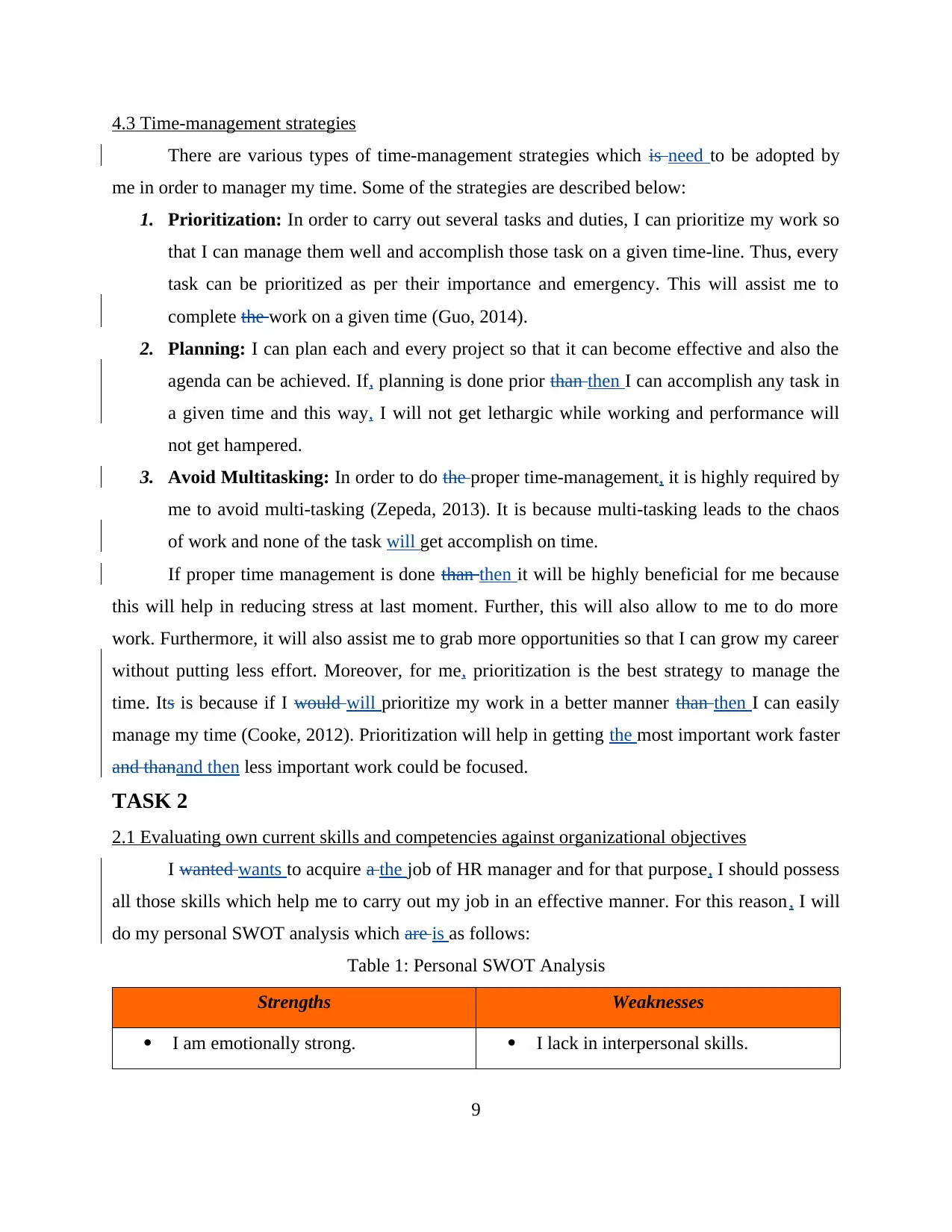
4.3 Time-management strategies
There are various types of time-management strategies which is need to be adopted by
me in order to manager my time. Some of the strategies are described below:
1. Prioritization: In order to carry out several tasks and duties, I can prioritize my work so
that I can manage them well and accomplish those task on a given time-line. Thus, every
task can be prioritized as per their importance and emergency. This will assist me to
complete the work on a given time (Guo, 2014).
2. Planning: I can plan each and every project so that it can become effective and also the
agenda can be achieved. If, planning is done prior than then I can accomplish any task in
a given time and this way, I will not get lethargic while working and performance will
not get hampered.
3. Avoid Multitasking: In order to do the proper time-management, it is highly required by
me to avoid multi-tasking (Zepeda, 2013). It is because multi-tasking leads to the chaos
of work and none of the task will get accomplish on time.
If proper time management is done than then it will be highly beneficial for me because
this will help in reducing stress at last moment. Further, this will also allow to me to do more
work. Furthermore, it will also assist me to grab more opportunities so that I can grow my career
without putting less effort. Moreover, for me, prioritization is the best strategy to manage the
time. Its is because if I would will prioritize my work in a better manner than then I can easily
manage my time (Cooke, 2012). Prioritization will help in getting the most important work faster
and thanand then less important work could be focused.
TASK 2
2.1 Evaluating own current skills and competencies against organizational objectives
I wanted wants to acquire a the job of HR manager and for that purpose, I should possess
all those skills which help me to carry out my job in an effective manner. For this reason , I will
do my personal SWOT analysis which are is as follows:
Table 1: Personal SWOT Analysis
Strengths Weaknesses
I am emotionally strong. I lack in interpersonal skills.
9
There are various types of time-management strategies which is need to be adopted by
me in order to manager my time. Some of the strategies are described below:
1. Prioritization: In order to carry out several tasks and duties, I can prioritize my work so
that I can manage them well and accomplish those task on a given time-line. Thus, every
task can be prioritized as per their importance and emergency. This will assist me to
complete the work on a given time (Guo, 2014).
2. Planning: I can plan each and every project so that it can become effective and also the
agenda can be achieved. If, planning is done prior than then I can accomplish any task in
a given time and this way, I will not get lethargic while working and performance will
not get hampered.
3. Avoid Multitasking: In order to do the proper time-management, it is highly required by
me to avoid multi-tasking (Zepeda, 2013). It is because multi-tasking leads to the chaos
of work and none of the task will get accomplish on time.
If proper time management is done than then it will be highly beneficial for me because
this will help in reducing stress at last moment. Further, this will also allow to me to do more
work. Furthermore, it will also assist me to grab more opportunities so that I can grow my career
without putting less effort. Moreover, for me, prioritization is the best strategy to manage the
time. Its is because if I would will prioritize my work in a better manner than then I can easily
manage my time (Cooke, 2012). Prioritization will help in getting the most important work faster
and thanand then less important work could be focused.
TASK 2
2.1 Evaluating own current skills and competencies against organizational objectives
I wanted wants to acquire a the job of HR manager and for that purpose, I should possess
all those skills which help me to carry out my job in an effective manner. For this reason , I will
do my personal SWOT analysis which are is as follows:
Table 1: Personal SWOT Analysis
Strengths Weaknesses
I am emotionally strong. I lack in interpersonal skills.
9
⊘ This is a preview!⊘
Do you want full access?
Subscribe today to unlock all pages.

Trusted by 1+ million students worldwide
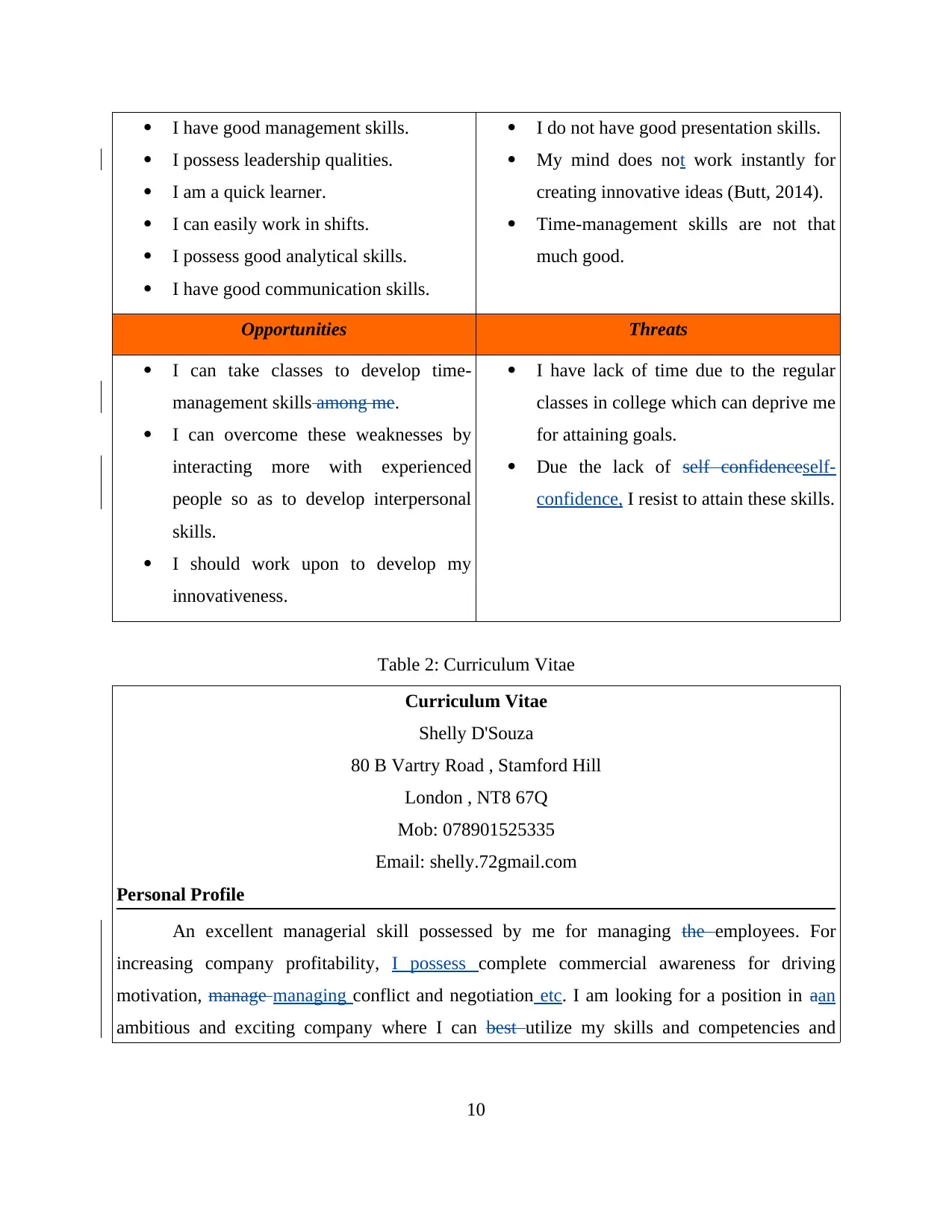
I have good management skills.
I possess leadership qualities.
I am a quick learner.
I can easily work in shifts.
I possess good analytical skills.
I have good communication skills.
I do not have good presentation skills.
My mind does not work instantly for
creating innovative ideas (Butt, 2014).
Time-management skills are not that
much good.
Opportunities Threats
I can take classes to develop time-
management skills among me.
I can overcome these weaknesses by
interacting more with experienced
people so as to develop interpersonal
skills.
I should work upon to develop my
innovativeness.
I have lack of time due to the regular
classes in college which can deprive me
for attaining goals.
Due the lack of self confidenceself-
confidence, I resist to attain these skills.
Table 2: Curriculum Vitae
Curriculum Vitae
Shelly D'Souza
80 B Vartry Road , Stamford Hill
London , NT8 67Q
Mob: 078901525335
Email: shelly.72gmail.com
Personal Profile
An excellent managerial skill possessed by me for managing the employees. For
increasing company profitability, I possess complete commercial awareness for driving
motivation, manage managing conflict and negotiation etc. I am looking for a position in aan
ambitious and exciting company where I can best utilize my skills and competencies and
10
I possess leadership qualities.
I am a quick learner.
I can easily work in shifts.
I possess good analytical skills.
I have good communication skills.
I do not have good presentation skills.
My mind does not work instantly for
creating innovative ideas (Butt, 2014).
Time-management skills are not that
much good.
Opportunities Threats
I can take classes to develop time-
management skills among me.
I can overcome these weaknesses by
interacting more with experienced
people so as to develop interpersonal
skills.
I should work upon to develop my
innovativeness.
I have lack of time due to the regular
classes in college which can deprive me
for attaining goals.
Due the lack of self confidenceself-
confidence, I resist to attain these skills.
Table 2: Curriculum Vitae
Curriculum Vitae
Shelly D'Souza
80 B Vartry Road , Stamford Hill
London , NT8 67Q
Mob: 078901525335
Email: shelly.72gmail.com
Personal Profile
An excellent managerial skill possessed by me for managing the employees. For
increasing company profitability, I possess complete commercial awareness for driving
motivation, manage managing conflict and negotiation etc. I am looking for a position in aan
ambitious and exciting company where I can best utilize my skills and competencies and
10
Paraphrase This Document
Need a fresh take? Get an instant paraphrase of this document with our AI Paraphraser
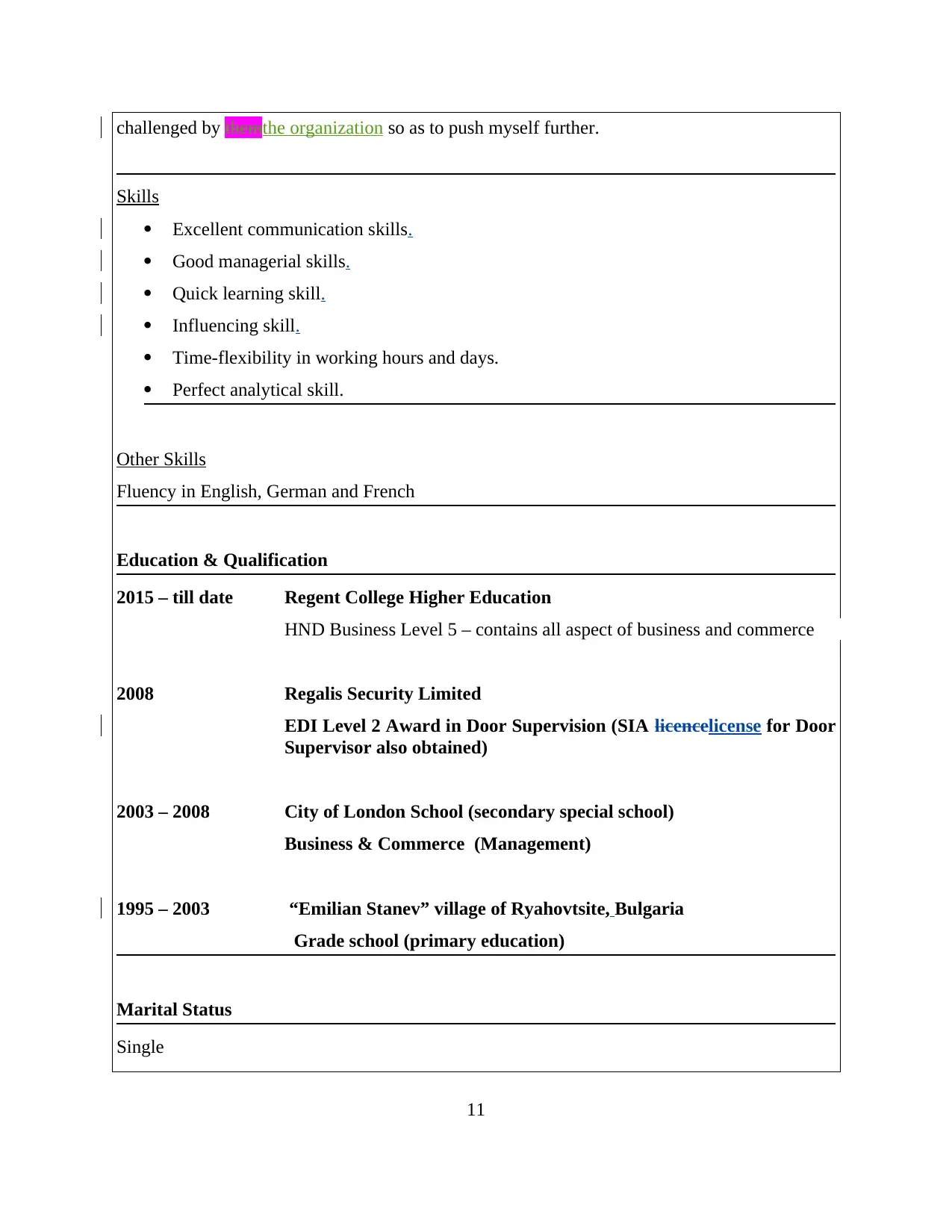
challenged by themthe organization so as to push myself further.
Skills
Excellent communication skills.
Good managerial skills.
Quick learning skill.
Influencing skill.
Time-flexibility in working hours and days.
Perfect analytical skill.
Other Skills
Fluency in English, German and French
Education & Qualification
2015 – till date Regent College Higher Education
HND Business Level 5 – contains all aspect of business and commerce
2008 Regalis Security Limited
EDI Level 2 Award in Door Supervision (SIA licencelicense for Door
Supervisor also obtained)
2003 – 2008 City of London School (secondary special school)
Business & Commerce (Management)
1995 – 2003 “Emilian Stanev” village of Ryahovtsite, Bulgaria
Grade school (primary education)
Marital Status
Single
11
Skills
Excellent communication skills.
Good managerial skills.
Quick learning skill.
Influencing skill.
Time-flexibility in working hours and days.
Perfect analytical skill.
Other Skills
Fluency in English, German and French
Education & Qualification
2015 – till date Regent College Higher Education
HND Business Level 5 – contains all aspect of business and commerce
2008 Regalis Security Limited
EDI Level 2 Award in Door Supervision (SIA licencelicense for Door
Supervisor also obtained)
2003 – 2008 City of London School (secondary special school)
Business & Commerce (Management)
1995 – 2003 “Emilian Stanev” village of Ryahovtsite, Bulgaria
Grade school (primary education)
Marital Status
Single
11
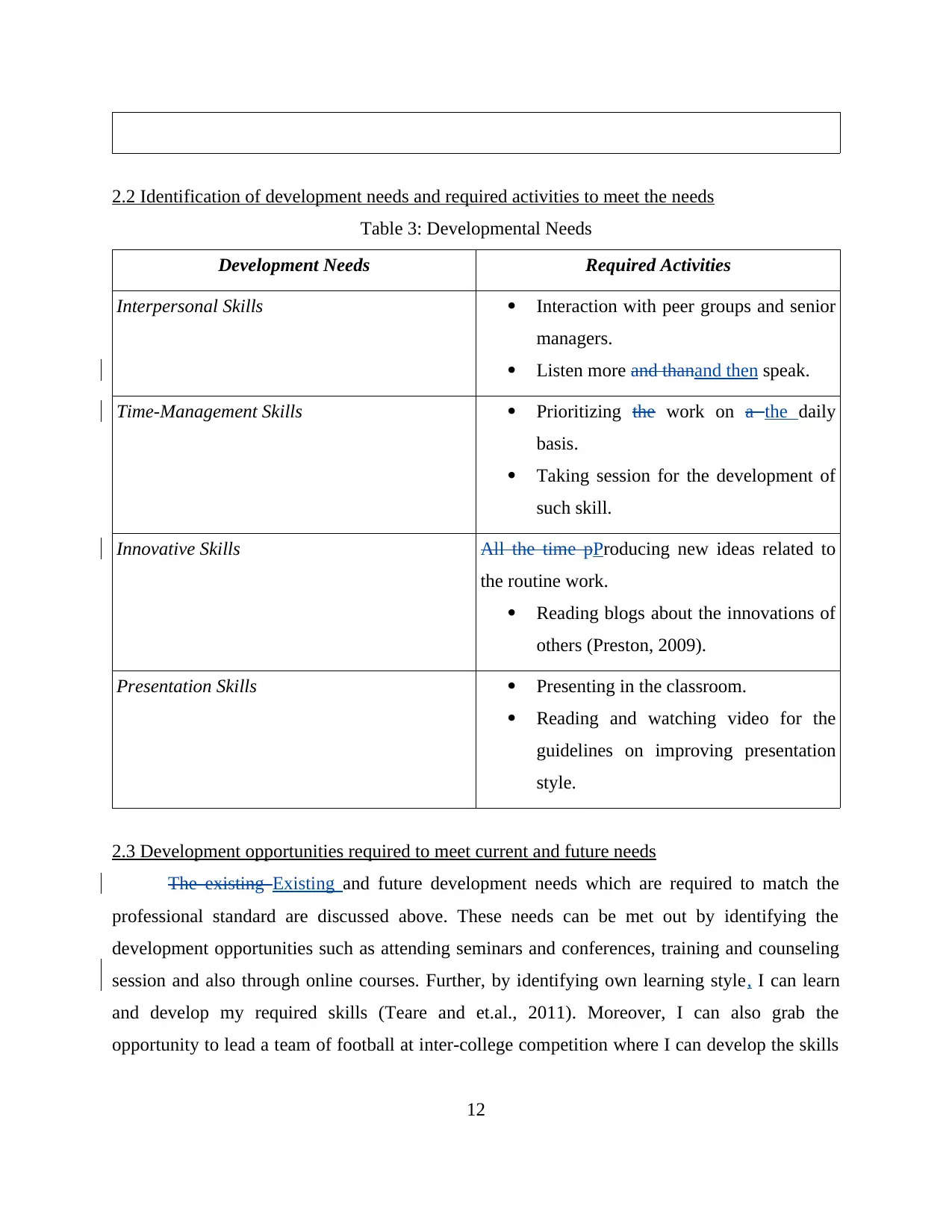
2.2 Identification of development needs and required activities to meet the needs
Table 3: Developmental Needs
Development Needs Required Activities
Interpersonal Skills Interaction with peer groups and senior
managers.
Listen more and thanand then speak.
Time-Management Skills Prioritizing the work on a the daily
basis.
Taking session for the development of
such skill.
Innovative Skills All the time pProducing new ideas related to
the routine work.
Reading blogs about the innovations of
others (Preston, 2009).
Presentation Skills Presenting in the classroom.
Reading and watching video for the
guidelines on improving presentation
style.
2.3 Development opportunities required to meet current and future needs
The existing Existing and future development needs which are required to match the
professional standard are discussed above. These needs can be met out by identifying the
development opportunities such as attending seminars and conferences, training and counseling
session and also through online courses. Further, by identifying own learning style, I can learn
and develop my required skills (Teare and et.al., 2011). Moreover, I can also grab the
opportunity to lead a team of football at inter-college competition where I can develop the skills
12
Table 3: Developmental Needs
Development Needs Required Activities
Interpersonal Skills Interaction with peer groups and senior
managers.
Listen more and thanand then speak.
Time-Management Skills Prioritizing the work on a the daily
basis.
Taking session for the development of
such skill.
Innovative Skills All the time pProducing new ideas related to
the routine work.
Reading blogs about the innovations of
others (Preston, 2009).
Presentation Skills Presenting in the classroom.
Reading and watching video for the
guidelines on improving presentation
style.
2.3 Development opportunities required to meet current and future needs
The existing Existing and future development needs which are required to match the
professional standard are discussed above. These needs can be met out by identifying the
development opportunities such as attending seminars and conferences, training and counseling
session and also through online courses. Further, by identifying own learning style, I can learn
and develop my required skills (Teare and et.al., 2011). Moreover, I can also grab the
opportunity to lead a team of football at inter-college competition where I can develop the skills
12
⊘ This is a preview!⊘
Do you want full access?
Subscribe today to unlock all pages.

Trusted by 1+ million students worldwide
1 out of 18
Related Documents
Your All-in-One AI-Powered Toolkit for Academic Success.
+13062052269
info@desklib.com
Available 24*7 on WhatsApp / Email
![[object Object]](/_next/static/media/star-bottom.7253800d.svg)
Unlock your academic potential
Copyright © 2020–2025 A2Z Services. All Rights Reserved. Developed and managed by ZUCOL.





